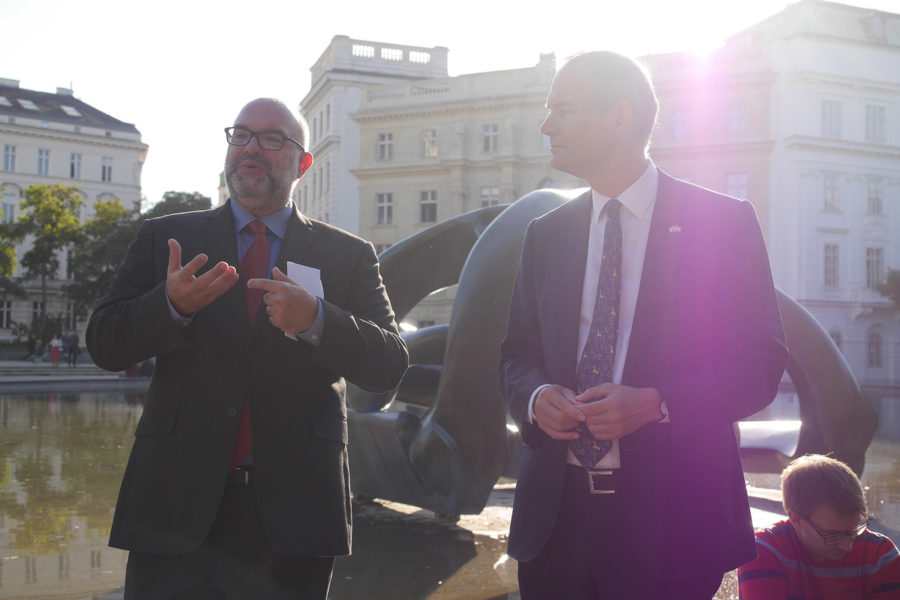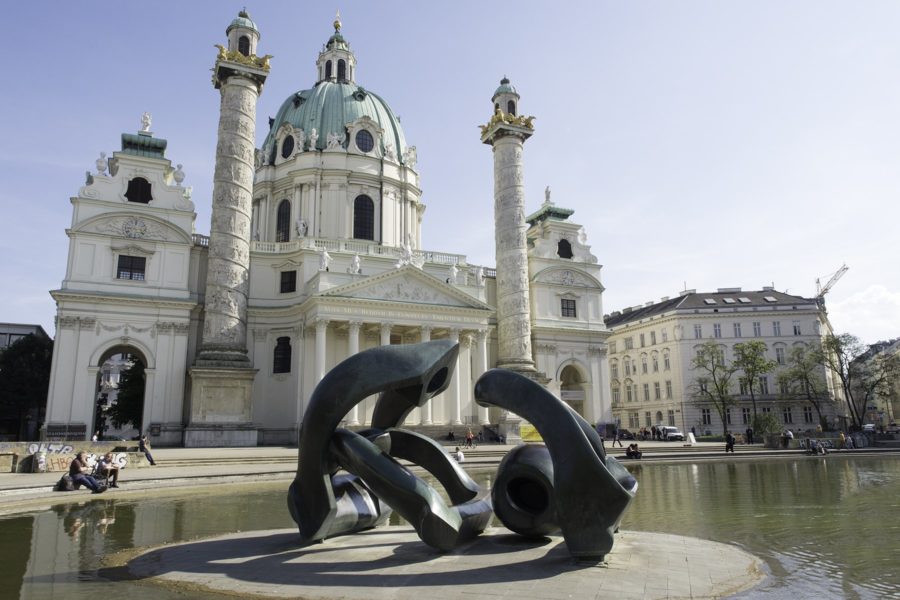12th December 2018 Vienna, Austria
A great Henry Moore in Vienna: domes, hills and protective parents

When I lived in Vienna in the 1980s I used to walk to work every day through the Karlsplatz. My path took my past the magnificent Karlskirche, completed in 1737. I also used to admire the beautiful elliptical pond, from which rose a large bronze work by the British sculptor Henry Moore, “Hill Arches”, installed at the site in 1978.

2018 marks the 40th anniversary of “Hill Arches” in Vienna. So we invited Sebastiano Barassi, Head of Collections and Exhibitions at the Henry Moore Foundation, to come and talk about the work and how it came to be here. You can see the text of his speech, which he delivered at the Karlsplatz, below.
Sebastiano’s text is worth reading in full. The highlight for me was learning that Henry Moore was able to influence the setting of the work in some detail. For example, he chose the colour of the tiles in the pond in which the work is set and the level of the water level (I sometimes wonder if the latter is still right); and also requested trees to be planted to hide the modern buildings around the Karlsplatz, in order to underline the relationship of his sculpture to the Baroque Karlskirche.
Moore also located “Hill Arches” off-centre in the pond, so that the curves of the sculpture would complement, rather than compete with, the dome of the famous church.
In addition to echoing the shape of the Karlskirche, the sculpture is said also both to be reminiscent of the rolling hills of Moore’s native Yorkshire and to suggest protective parents with their child.
I continue often to walk through the Karlskirche, and will now look at Henry Moore’s beautiful statue with new eyes. Please do have a look at Sebastiano Barassi’s lecture below; and enjoy a masterwork of 20th century art alongside a masterwork of 18th century architecture whenever you are in the Karlsplatz.
Lecture text
Hill Arches 40th Anniversary: an address by Sebastiano Barassi, Head of Collections and Exhibitions at the Henry Moore Foundation
Vienna, 4 October 2018
Henry Moore is arguably best known for his monumental sculptures, which for decades now have been prominently displayed in public spaces across the world – today, there are examples of his outdoor works in 38 countries and 270 cities on five continents. Yet, I find it quite difficult to think of a location in which the relationship of Moore’s sculpture with the architectural surroundings is as compelling as it is here. Having, over the years, given many speeches at exhibition openings, I have often found myself speculating whether Moore would enjoy seeing his work presented in a particular context. Here, we know for certain that the site was one that he not only liked very much, but which he had in fact contributed to shape, and which he considered perfect for his work.
The idea of having a major piece by Moore on display in Vienna was first mooted in 1969 by the painter Georg Eisler, who was at the time also the President of the Vienna Secession. By then Moore had already had two important solo exhibitions in the city, both organised by the British Council: Henry Moore: Zeichnungen, Kleinplastik, Graphik in 1951 at the Albertina, and a big retrospective at the Akademie der Bildenden Künste in 1961. So when he and Eisler started to discuss this idea, Moore, who was by then at the height of his international success, was a familiar and much admired figure in Austria.
Crucially, Moore had a great affection for Vienna too, so the idea of having one of his monumental pieces permanently sited in the city really appealed to him. And I think there can be little doubt that the royal treatment he received every time he came to the city did contribute to his love for it. We know, for example, that when he visited in 1973 he stayed at the Hotel Sacher, saw Richard Strauss’ Der Rosenkavalier at the Opera and was lavishly entertained for two days. It should come as no surprise, then, that during that visit he told an Austrian journalist that he had always associated Vienna with gaiety, and that he hoped that by having one of his works in the city, some of that happiness would be passed on to him. And Vienna certainly loved Moore back. Artists like Fritz Wotruba and Alfred Hrdlicka spoke very highly of him, and shortly after the first meeting with Eisler, Moore was made an Honorary Member of the Vienna Secession. A few years later, in 1975, he was also made an Honorary Member of the Akademie der Bildenden Künste. I am quite sure that these honours, together with the success of the earlier exhibitions, played an important part in Moore’s decision to give a sculpture to the city as his gift. Incidentally, this was Moore’s second gift to Vienna – the first had been the sculpture Woman he donated in 1962 to the museum which is today the Mumok. Moore’s generosity and the city’s affection for him were again celebrated in 1998, with a major retrospective of over 120 works organised at the Palais Harrach to coincide with his 100th birthday.
Although Moore took the decision to donate a sculpture quite quickly, discussions about the choice of an appropriate work and its siting continued for some years. This wonderful site in front of the Karlskirche was first discussed with Moore in 1971. Although he immediately agreed that it would be perfect, at that time a complete redesign of the square was being planned by the Danish architect Sven-Ingvar Andersson, which required a few years to complete. After studying the architect’s plans and considering carefully the relationship with the church and the square, in 1973 Moore decided that a recent work, Hill Arches, would be the most suitable gift. Once the renovation of the square was completed, and some public opposition had been overcome (something which Moore had got used to when his sculptures were shown in historical city centres), in April 1978 Hill Arches was finally installed in this beautiful square, under Moore’s supervision. Working closely with the architect and the city planners, Moore was allowed to influence some of the decisions about the site.
He was able, for example, to choose the water level and the colour of the tiles in the pool, and he requested to have trees planted in front of the modern buildings around the square, to help emphasise the relationship of the sculpture with the Baroque forms of the Karlskirche. This attention to detail was quite typical of Moore’s approach, since he always considered very carefully the relationship of his work with the surrounding architectural and urban spaces. Moore found the Karlskirche more beautiful each time he saw it, and suggested siting the sculpture off-centre in the newly-built pond to avoid competing with the architecture. Tellingly, he later referred to Hill Arches as ‘a Baroque sculpture for a Baroque church’.
Hill Arches was a relatively recent work, conceived in 1973. It is an uncharacteristically complex four-part piece, combining three stirrup-like shapes and a large spherical form. The forms are quite gentle – and critically for its choice, the curves of the sculpture echo the dome of the church. The normal equation of human forms with landscape, so central to Moore’s thinking, is not immediately obvious here. There seems to be echoes of his more abstract sculptures of the 1930s, which were based on the arrangement of multiple forms on a base. And by the late 1960s Moore had returned to an abstract idiom for his more monumental works. Yet, the title openly refers to landscape, perhaps a suggestion of the rolling hills of his native Yorkshire, making this quite a unique piece in Moore’s oeuvre, in a way a landscape in its own right.
Hill Arches has also sometimes been referred to as a children’s favourite, perhaps because of what Moore said about it, that its forms are suggestive of protective parents with their child – an echo of his shelter figures, and of the ‘mother and child’ and ‘family group’ themes which were so central in his work.
The ideas of protection and shelter were certainly very important in Moore’s thinking and in his visual language throughout his career. Initially inspired by his wartime experiences, they came to symbolise his humanism and desire to promote friendship between peoples, especially in the aftermath of the Second World War.